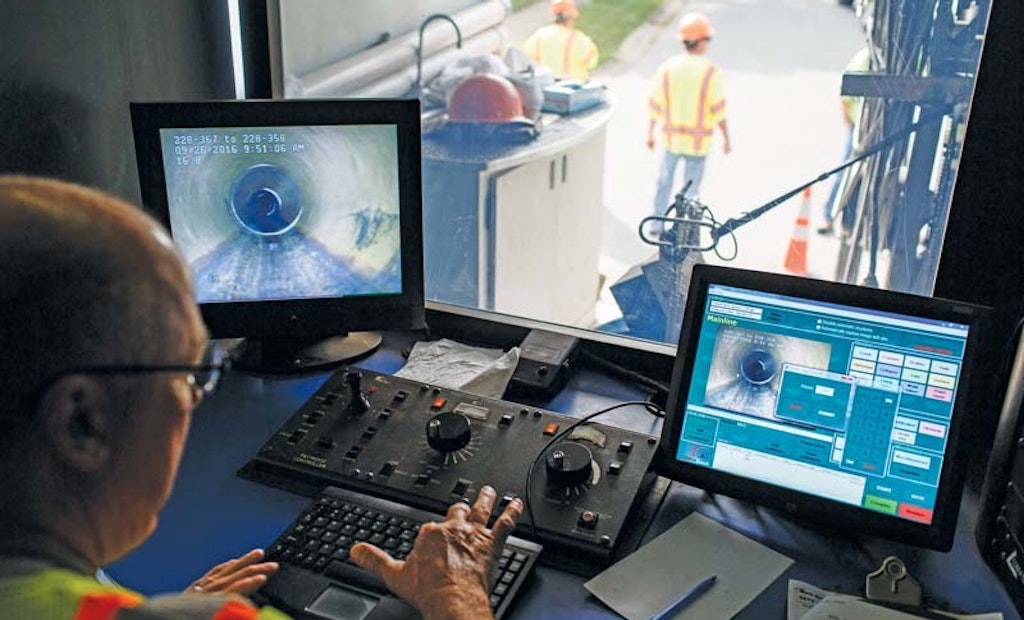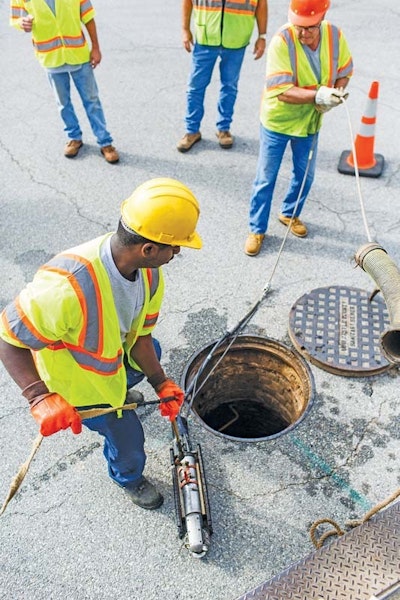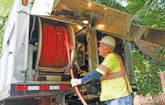
Interested in Inspection?
Get Inspection articles, news and videos right in your inbox! Sign up now.
Inspection + Get AlertsIn the late 1980s, New Castle County, Delaware, moved away from a reactive approach to its sewer maintenance. But it took another two decades, as well as a mandate from the EPA and state regulators to rehab the oldest portion of the collections system to combat chronic SSOs, before those efforts really took off.
Now, SSOs are way down (about 82 percent from the numbers a decade ago) and the utility continues to make gains. Keys have been investing in new technologies — even when equipment budgets are tight — and effectively striking a balance between in-house and contracted work.
“With any change in our maintenance programs we want to do two things: save money and increase system performance,” says Rob Roff, operations services manager for the Environmental Operations Division, which heads up collections system maintenance.
Constantly trying to meet those two objectives has allowed the utility to not just avoid a reactive mentality, but also fully embrace the idea of taking a proactive approach. Important, says Roff, because getting on top of today’s collections system issues doesn’t mean New Castle County’s work is over. The utility must anticipate future issues.
“It just never stops,” he says.
A multifaceted approach
Delaware is one of the smallest states in the country and is made up of only three counties. That doesn’t mean the utility of New Castle County has it easy though. Of those three counties, it is the most populous with 550,000 people. The utility maintains a 1,700-mile collections system with 169 pump stations and 44,000 manholes. Pipe ranges from 6 to 84 inches in diameter. A team of 54, including Roff and superintendent Bob Richardson, make up the division that maintains the gravity collections system.
The sewer maintenance philosophy was reactive for many years, but the utility began taking a more proactive approach in the late 1980s. The first initiative was a regular cleaning program.
“We had a large investment in equipment and people to make that happen,” Roff says. “We took the system and cut it into 400 service areas and assigned them a cleaning frequency, anywhere from six months to five years. That dramatically changed the way we did business, but it also moved things in the right direction as far as system performance.”
The cleaning program was a step in the right direction, but it wasn’t enough. New Castle County suffered from SSOs, particularly in the northernmost — and oldest — part of its system. A mandate from regulators came down around 2007 to rehab that area (known as the Brandywine Hundred) and lower the number of SSOs. The order included cleaning a minimum of 500 miles of pipe per year, launching dedicated chemical root control and trunkline maintenance programs, and developing a more enhanced CCTV inspection program.
The new initiatives have helped. In 2008, not long after the programs were put into place, there were 89 SSOs. In 2015 there were 16.
Stretching resources
Much of the work associated with the mandated programs is contracted out. For example, Duke’s Root Control handles the chemical root control program for New Castle County. Roff says it’s been a challenge smoothly integrating that work alongside the utility’s in-house programs.
“It’s a big enough challenge coordinating a preventive maintenance cleaning program — and we now have almost 1,000 different sewer sheds we clean — but then you throw in things like a root control program, and we have to track all that work too and make sure people don’t end up in the same place on the same day. There’s a lot of coordination,” Roff says.
The utility’s Cityworks software has helped on that front. But having outside contractors involved has also maximized all the in-house cleaning efforts.
“For example, our crews used to go into different neighborhoods and mechanically root cut an average of once a year,” Roff says. “After we brought on the dedicated chemical root control program and put those neighborhoods into it, we were able to take the crews that would root cut for days on end and move them to different parts of the system we were perhaps having a hard time getting to so we could stay on schedule with our cleaning.”
Stretching resources as much as possible has been important because despite all the various programs in place, funding has been limited. In 2008, the sewer maintenance division’s operating budget was increased in order to absorb the new programs. The intent of government officials was to gradually allocate even more funds to those programs in the following years, but that never materialized, Roff says. Budgets have stayed flat.
“We’re always looking at saving money and stretching resources further,” he says. “The chemical root control program is a good example of that because it frees up our in-house cleaning crews to go into other areas and help keep the cleaning schedule on track, but there’s also been a dramatic drop in root-related SSOs and mainline stoppages. If we’re going to the same neighborhood every year to root cut and now all of a sudden we don’t have to go to that neighborhood except every three to four years, that’s dramatically changing the landscape of how we do business.”
Another example is the series of pilot studies New Castle County has done with the SL-RAT (Sewer Line Rapid Assessment Tool) from InfoSense for the past year. In previous years, the utility would clean every inch of a sewer shed as it came up on the schedule. What’s been learned though, Roff says, is that some portions of pipe in a sewer shed may not even need a cleaning when its turn comes up. The utility is exploring how to use the SL-RAT ahead of a cleaning cycle in order to eliminate cleaning some lines and ultimately cover more ground more effectively.
“So far we’re seeing positive results and realizing that we could save a lot of time by not cleaning every line,” Roff says. “It’s about 25 percent that doesn’t have to be cleaned in older systems, to as high as 50 or 60 percent in newer systems. The question is how do we incorporate this and calculate the savings. We’ve overcome a big hurdle with the EPA and our state regulator. They now view the SL-RAT analysis as contributing to our 500-miles-per-year cleaning requirement. We’ve proven to them that the pipe is free-flowing. We’ll probably still stick with actually cleaning 500 miles a year, but with the SL-RAT evaluation we’ll be reaching more of the overall collections system. Again, it’s about stretching our in-house resources further.”
Tech investment
Bringing in new tools and technology like the SL-RAT is another key component to New Castle County’s attempts to maximize results with existing resources.
“Even though we’ve had to absorb a relatively flat budget, the goal is still to get positive results, so a focus has been improvements in technology all the way down to nozzle technology,” Roff says.
To that end, the utility has started to invest more in anti-blowback nozzles from Enz USA.
“We were hesitant at first when we heard about them, but the more we read up on them, it seemed like it might work,” Richardson says. “We bought one nozzle and took it to an area notorious for blowbacks. After using that nozzle we didn’t have one blowback or complaint. Now we’re investing more in them.”
Roff notes that it’s a major investment, but the payoff is huge because nobody likes to take phone calls about blowbacks.
“Service to the customer comes first,” he says. “I think sometimes equipment operators tend to have a favorite nozzle. It’s gotten them out of a jam in the past maybe and they would probably sleep with it under their pillow if they could. But we’re trying to get out of that mentality of using one nozzle for all our cleaning and embracing newer ones that have more specific uses.”
A limited budget makes equipment upgrades a challenge. For New Castle County, it isn’t about one large investment, but rather smaller ones over time.
“It’s just a matter of prioritizing purchases, and we do a lot of phasing in,” Roff says. “We started with one Enz nozzle to see how it would work and got very good results. We can’t outfit all our people in one year, so you just have to decide where you’re going to spend the money. We do the phase-in approach and buy a certain amount of nozzles each year.”
A foggy future
The next major issue Roff anticipates taking on is FOG. Currently, his division maintains a list of “hot spots” that receive regular cleanings. CCTV inspections have helped gauge the rate of buildup in those areas, and action is taken accordingly, whether that means more frequent cleanings or fixing the underlying problem, such as a pipe sag. Grease additives are used in the sewer jetter trucks, and grease-eating bacteria are used in about 70 drop sites throughout the county. Still, Roff says it’s an issue New Castle County needs to get ahead on.
“We still have a fair amount of development in New Castle County,” he says. “Our largest mall just had an expansion. Restaurants are always opening. Every time new development happens it changes the characteristics of your system. I think that’s where we need to try to get ahead of the game. We at least have to have a system in place to keep it in check.”
As they have been up to this point in all of New Castle County’s proactive sewer maintenance efforts, the answers to the FOG problem will likely be driven by a combination of both savings and system performance.
“The goal is to not have a mainline stoppage or SSO because of grease, but it’s also to limit resources to accomplish that,” Roff says. “I feel like we need to take a hard look at it and apply the same philosophies we’ve had in the past: What are we doing wrong and what can we do better? Then hopefully in a couple years we’ll see a return on that.”
Brandywine rehab plays important role
Cleaning can’t cure all ills. New Castle County’s aggressive sewer maintenance program has been complemented over the last decade by the Brandywine Hundred Sewer Rehabilitation project.
“The Brandywine rehab is part of the original state order that some of our maintenance programs are under, but all that work is under the engineering division,” says Rob Roff, operations services manager for the Environmental Operations Division. “It’s been a very aggressive evaluation and rehab of the upper collections system.”
That upper area of New Castle County, the Brandywine Hundred, is home to the county’s oldest underground infrastructure, much of it deteriorating vitrified clay contributing a lot of I&I to the collections system. Phase One, which wrapped up in 2014, focused on the most critical areas. A second phase is currently underway taking care of areas not in as dire a need for repair but still contributing measurable I&I to the system.
“There’s been a lot of trenchless technology used when possible such as pipe lining, and some replacement as needed for capacity or structural reasons,” Roff says. “As that program has gone forward in the last 10 years, the system performance has gotten better, which benefits us maintenance-wise. Now that there are lined pipes up there, we’ve been able to switch the cleaning frequencies of those neighborhoods. Where we used to go in once a year to prevent issues, we’ve been able to flip to cleaning every three years. The Brandywine rehab is separate as far as what’s done in our division, but it all benefits us in the end. It all works together.”
That trickle-down benefit from pipe rehab to maintenance will continue in New Castle County.
“A fair amount of pipe has been addressed as part of Brandywine, but there are other parts of the system getting older,” says Roff. “It will be important to stay on top of things and keep up our system performance, whether that’s through regular maintenance or rehab.”








